The Gable Ionic Charger (ca. 1965)
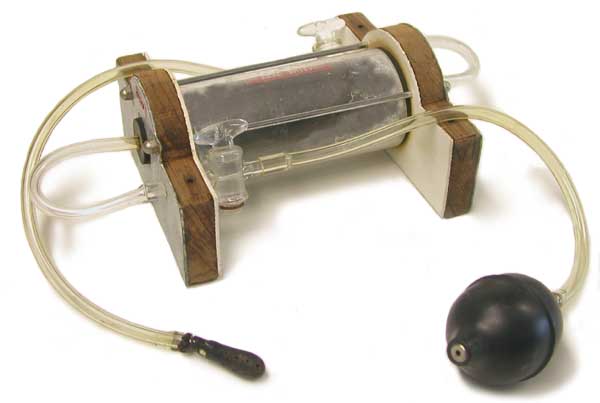
The "ionic charger" featured here was produced by the Luther Gable’s Ionic Research Foundation in Winter Park, Florida, probably during the early 1960s. The "Foundation" (i.e., Luther Gable’s house) described itself as a center for "Balneology, Horticulture and Animal Husbandry, Fluorescence, and Atomic Engineering."
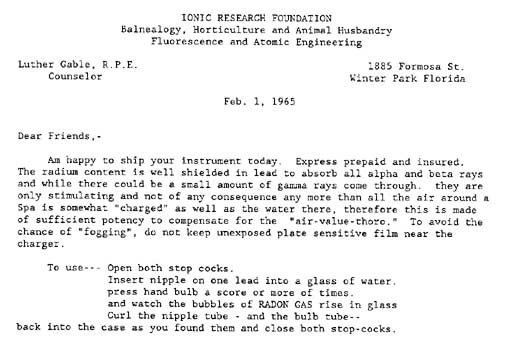
The following image shows the first part of a letter that Luther Gable sent to those who purchased the Ionic Charger.
The device contained a substantial amount (100 uCi?) of Ra-226 inside a cylindrical lead shield that was approximately 5" long and 2 1/2" in diameter. The gamma exposure rates were sufficiently high that we had to remove and dispose of the source, not something that should be attempted without the proper equipment and knowledge. A large (ca. 2" diameter) squeeze bulb was connected with Tygon tubing to one end of the cylindrical chamber, and a small bulb with holes in it was connected to the other end.
In use, the small bulb was placed into a glass of water and the large bulb was squeezed "a score or more of times." You could then "watch the bubbles of radon gas rise in the glass." The water, now radioactive, was not only for drinking, but also for "plants you are watering, seedlings you are raising, or animals."
According to Gable, drinking the radioactive water was safe because it was radon gas that was ingested, "not the metallic element" (i.e., radium). He also noted that:
"the current generation of professional men has been brainwashed by bureaucratic screaming about fall-out and the truth of the famous spas has been lost sight of."
The standard price was $575, but educational institutions could receive a 40% discount.
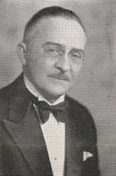
Luther Gable
Gable definitely believed in the medical benefits that would result from drinking radioactive water. As early as 1931, he indicated that he was drinking "Radium Highballs" on a daily basis. This concoction had a "base of grape and lemon juices and the "kick" was furnished by radon" (Manitowoc Herald News, June 24, 1931). When giving lectures, he sometimes served Radium Highballs to members of the audience.
One of Gable’s many claims was that he invented the first American radium emanator (Chronicle-Telegram. March 27, 1937). His "ionic charger" looks primitive enough, but the earliest references I have to it are from the 1960s. Interestingly, the following photograph, probably from the 1930s, shows Gable with a "Radiumator" (aka Standard Radium Emanator)—the latter is seen on the right side of the image. The patent for this device was filed by Alfred Henry Tyrer of Toronto, Canada. I mention this because the design of the Radiumator looks like it might have been the inspiration for Gable’s Ionic Charger.
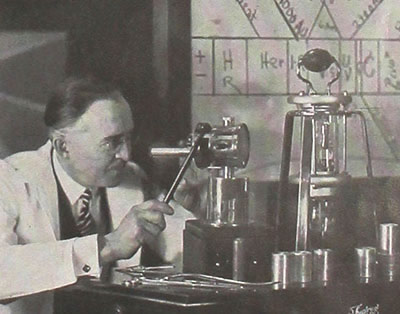
My guess is that the first American radium emanator was produced by the Standard Chemical Company (SCC) of Pittsburgh. An SCC brochure with a 1913 copyright describes this emanator as follows:
"For supplying Radium emanation for inhalation and for charging drinking and bath water with Radium emanation gas [radon]."
Gable claimed to have worked for SCC, and if he did, he might have been involved with the production of their emanator. However, there is no independent evidence that he worked for the company—we only have his word for it.
I am not sure when the Food and Drug Administration (FDA) first became concerned about the Ionic Charger, most likely it was 1965. They seem to have begun seizing Ionic Chargers in January 1966 (Atchison Globe Daily, Jan. 26, 1966), and a 1966 FDA Report on Enforcement and Compliance mentions the case. An undated copy letter from the assistant general counsel in the FDA’s Food and Drug Division was sent to the United States Attorney in Oklahoma requesting that one such device in the town of Ardmore be seized. The justification given for the requested seizure was that statements made by the Ionic Research Foundation concerning the Ionic Charger were "false and misleading." Ironically, the examples given in the FDA’s letter of these false and misleading statements were exact quotes Gable had taken from a publication of George H. Torney, the Surgeon General of the United States Army (ca. 1910).
Luther S. H. Gable: Important Dates and Facts
1880. Luther Stansbury Hooper Gable was born October 24, 1880 in Shamokin, Pennsylvania.
1907. Gable married Hattie (Harriet) E. Russell, also from Pennsylvania. At the time, he was 26 and she was 20. The marriage form gives his occupation as salesman. Gable is listed in the Pittsburgh City Directory.
1910. On the 1910 census form, his occupation was listed as travelling salesman.
1913. Gable is described as a salesman in the Pittsburgh City Directory.
1918. His draft registration card for 1917/1918 identifies his occupation as a salesman for the York Steel Corporation in Pennsylvania.
1920. The 1920 census and Aurora City Directory indicate that he was living in Aurora, Illinois. His occupation was identified as salesman. The 1924 Aurora City Directory still identifies him as a salesman.
1926. The Chicago City Directory indicates that Gable is living there.
1930. The 1930 census had two separate entries for him: one has him residing in Brookfield, Illinois with Hattie, and the other indicates that his residence was in Detroit, Michigan. In each entry his occupation was listed as salesman. He apparently had some type of relationship with the Detroit Institute of Technology. The 1930 Detroit City Directory indicates that he was a physiotherapist. He was not listed in the Detroit City Directory for any other year.
1940. In 1940, the census indicated that the Gables were living in the unincorporated Mountain Precinct just southwest of Denver, Colorado. He now listed his occupation as a lecturer.
1942. His 1942 draft registration indicated that he was living in LaGrange, Illinois.
1949. In 1949, his book "The Miracle of Television" was published. He was now living in Chicago and may have been associated in some way with the American Television Institute.
1960s. By the 1960s, the Gables were living in Winter Park, Florida, and his Ionic Research Foundation was manufacturing and selling Ionic Chargers.
1961. Hattie Gable passed away in 1961.
1965/1966. Federal marshals begin seizing Ionic Chargers at the request of the Food and Drug Administration.
1966. Gable married Marjorie Clore.
1967. Luther Gable died December, 1967. He was 87.
Gable’s Degrees
At various times, Gable attached the following to his name: PhD, RPE, and PhT.
The first reference to a Dr. Gable that I have found is from 1921 (El Paso Herald, June 25). While it is not clear where, when, or if Gable received a Ph.D., the prestigious American Association for the Advancement of Science thought he had one. Their 1948 publication "The American Association for the Advancement of Science, A Brief History of the Association" includes the following entry in its listing of AAAS members:
"Gable, Luther S. H. (1880); 5240 Sixth Ave., La Grange, III.; Ph.D. Polytechnic Coll. Liberal Arts."
Unfortunately, it is not obvious what school "Polytechnic Coll." refers to. I did find the following reference to his field of study when seeking his PhD:
"He majored in electromagnetic radiations and ionization" (Oshkosh Northwestern. Jan. 15, 1962).
In his book "The Miracle of Television," he is identified as Luther S.H. Gable, Ph.D., R.P.E. I am not sure what the R.P.E. referred to (Registered Professional Engineer?), but Gable liked it - it was the only title he seems to have used in his Ionic Research Foundation correspondence.
Gable’s Academic Positions
From 1930 to 1934 or so, Gable had some sort of relationship with the Detroit Institute of Technology. A few press accounts even indicated that he headed a department there.
"Dr. Gable is head of the Department of Radium and Heliology at the Detroit Institute of Technology and stands alone in his field. This school was the first in the country to offer this unique and ultra-modern scientific course" (Oak Parker, Dec. 31, 1931).
That he held such a position would be easier to believe if there was something to suggest that such a department really existed. It is possible, even likely, that Gable gave presentations at the school, but head the Department of Radium and Heliology? Nah. Nevertheless, no one can dispute that he stood "alone in the field."
By the early 1950s, the Gables were living in Chicago and the field of Radium and Heliology back in Detroit was empty. Gable’s interests had turned to television, and press accounts began referring to him as a:
"special instructor at a television laboratory in Chicago where over 4,000 students are in training as television engineers." (Kingsville Record, April 9, 1952).
This "laboratory" was probably the American Television Institute, a first rate operation, and there is no reason to doubt that Gable was an instructor there. After all, Gable had two decades of glowing publicity to back him up - he had even played at Carnegie Hall for the Academy of Science. Furthermore, he was the author of a real book: "The Miracle of Television" (Wilcox & Follett, Co., 1949).
Gable First Becomes Interested in Radium
Gable explained that his interest in radium began when he first read about its discovery by Marie Curie while he was in high school (ca. 1898). What seemed to intrigue him the most was that radium glowed in the dark (Daily Times Record. Oct. 26, 1942). Indeed, when he was on the lecture circuit, Gable’s favorite demonstrations involved the use of black-lights and spinthariscopes.
Radium Engineer of Note
In 1915, the United States government was attempting to seize control of the radium deposits in the southwest. Needless to say, this was of great concern to the radium industry and Standard Chemical Company in particular.
Responding to this threat of a government takeover, a short note appeared in the December 4, 1915 issue of the Philadelphia Evening Public Ledger under the title "Radium Producers Allege Government Favoritism." The note went on to say, in part:
"In the Sunday Public Ledger, Stansbury Gable, a radium engineer of note, deliberately goes on record that a great American industry has been brought to a halt."
The next day the promised article appeared and it was substantial, nearly a full page.
The reason that he authored the article as Stansbury (his middle name) Gable rather than Luther Gable is not obvious. His son's name was Stansbury, but the latter was too young to have made it into high school let alone qualify as a "radium engineer of note."
For what it is worth, my take on all of this is that Luther Gable was a salesman who really wanted to be a "radium engineer/scientist." Writing this article was his way of becoming one. That it was published seemed to prove that you are what you claimed to be.
"Radium"
In 1921 Gable published an article titled "Radium." It wasn’t a technical paper, it was more of a simple overview of the subject (American Surgical Trade Association Journal. Vol. 8 No. 4. 1921).
One thing worth noting: the paper referred to Gable as "Formerly associated with the Standard Chemical Company of Pittsburgh."
"Magic Story of Radium"
The "Magic Story of Radium" was an almost daily series of newspaper articles attributed to "Dr. Luther Gable" that were published in June, July and August of 1921. The earliest that I have found, "Mme. Curie's Zeal Is Undaunted By Husband's Tragedy," appeared June 22 (El Paso Herald). In none of these articles, at least to my knowledge, did he claim to be affiliated with the Standard Chemical Company. Nor did he claim to have any direct involvement in the radium industry.
Paradox Radium Laboratories, Inc.
In August of 1921, Gable copyrighted the name "Paradox Radium Laboratories." The latter refers to the Paradox Valley in Colorado where Gable would later claim to have successfully prospected for radium. A listing in the Catalog of Copyright Entries is the only place where I have seen Gable’s name linked to the company. Other sources identify the following principals: Frank D. LeVan, Carl W. L. Wermine, Rurrell J. Cramer and Harry Linder. If Gable had an active role in the company, it is reasonable to assume that it involved sales.
The stated purpose for the company’s incorporation was to produce radium and radioactive products. These included Radium Ointment, Radium Tablets, Radium A Wine (42.50 for a 16 oz. bottle) and Hydro Radium. Each 2 oz. bottle of the latter was said to contain 2 micrograms of radium element—essentially the same as William Bailey’s Radithor.
Paradox Radium Laboratories appears to have occupied at least two addresses: 639 Webster Avenue, Chicago and 1012 North Clark St., Chicago.
The last reference I have for the company is from 1925.
Gable’s Claim to have Worked for Standard Chemical Company
The most detailed account of his time at SCC appeared in what might have been his first press interview (Suburban Magnet, Aug. 28, 1930). In the interview, Gable described two events that help assign years to the time he supposedly worked at Standard Chemical Company. One involves Gable being present when Joseph Flannery, the company president, was shown the first 2 grams of radium produced at SCC. These two grams were produced in 1913. The second event/story has Gable rushing to the home of Emile Krapf after the latter’s death and finding "two grams of radium setting just in front of the spot where his head had dropped." Krapf died in April of 1915. If true, these statements have Gable working at SCC at least from 1913 to 1915.
Another claim regarding his time with SCC:
"As a technician for the Standard and Radium Chemical Companies at Pittsburgh, he organized and instructed one of the first radium therapy societies for the treatment of cancer with radium." (Chronicle-Telegram, Mar. 27, 1937).
Do these claims hold water?
For most of the time that Standard Chemical Company was refining radium (ca. 1911-1921), Gable lived in Pennsylvania. As such, Gable’s story has to be considered possible.
Official documents from 1907, 1910, 1917/1918, 1920 and 1930 identified his occupation as salesman. From 1913 to 1915 when Gable (according to him) was supposed to be working at Standard Chemical Company, their business was booming and they would have needed salesmen. In fact, the 1913 Pittsburgh City Directory indicates he was working as a salesman in that city. However, his draft registration card from 1917/1918 indicated that he worked for York Steel. Perhaps he left a job at SCC?
One obstacle to believing his accounts is that their details are frequently inaccurate or implausible, e.g., that Emile Krapf died suddenly at home as a result of his work with radium. In reality, Krapf died due to pneumonia at the home of his parents-in-law (Pittsburgh Daily Post. Apr. 10 1915). The same story had Gable finding two grams of radium next to the location where Krapf’s body was found. Given the monetary value of two grams of radium, not to mention the hazard, it is totally implausible that Krapf would have had that much radium at his home.
Another whopper from the same article (Suburban Magnet, Aug. 28, 1930):
"we divided the radium up into smaller quantities, placed them into small metal containers, connected them in series with a small motor. It promptly started to run."
If you believe that, I have a bridge to sell you. What Gable has done here is appropriate components of a story told by Alfred M. Hubbard, an even stranger individual than Gable—check him out online. To his credit, some of Hubbard's claims were actually true, his invention of the radioactive spark plug, for example.
Gable goes on to describe the end of his ground breaking research:
"We were just getting ready to report even more sensational applications. We were on the verse of discovering industrial uses almost as revolutionary as perpetual motion would he if announced - when all our labor, ingenuity and hopes were frustrated, made worthless in a single day."
What did them in, according to Gable, was the arrival in New York of the first radium shipment from Belgium - radium that would sell at a far lower price than anything Standard Chemical Company could match. The difficulty with this story is that radium wasn’t refined in Belgium until 1922, and by this time Gable had been living in Illinois for at least two years.
I am only aware of newspaper stories and one Scientific American article that link Gable to the company. None of these can be considered very credible since their source of information was Gable himself. Furthermore, they were published during or after 1930 when Gable had switched careers from salesman to professional lecturer. In other words, the claims began at a time when it would have been advantageous for him to embellish his resume.
The most authoritative accounts regarding those who worked at Standard Chemical don’t mention Gable, e.g., the reminiscences of Arthur Miller who worked at SCC from 1914 until its dissolution. Furthermore, Joel Lubenau who authored a history of Standard Chemical Company, has gone to great lengths to identify all of the individuals who were employed at SCC. Although he could not rule out the possibility that Gable had worked there, neither could he confirm it (personal communication).
Gable’s Claim Regarding his Discovery of Radium Deposits
"Later through the influence of Joseph M. Flannery, of Pittsburgh Penn., who started the first radium company in America, I was sent to Colorado in search of radium." (Daily Times Record. Oct. 26, 1942).
"he found the first United States radium deposits (in Colorado), and more recently located pitchblende in the Arctic." (The Miracle of Television. Luther S.H. Gable, Ph.D., P.R.E. Wilcox & Follett, Co., 1949).
Where there is uranium, there is radium. Pitchblende, a uranium-containing mineral, was discovered in Colorado in 1871. Another uranium containing mineral was discovered in Colorado in 1881 (Gable was one year old at the time), but it wouldn’t be given the name "carnotite" until 1898. A year later, in 1899, the Curies confirmed that carnotite contained uranium and radium.
Well before Flannery developed an interest in radium, various attempts had been made to extract radium from Colorado ore, most notably, those of Stephen Lockwood and Thomas Walsh (Landa. "Buried Treasure to Buried Waste." Col. Sch. Mines Quarterly. 82 (2). 1987).
The key reason that Gable’s story doesn’t hold up is that SCC didn’t prospect for radium or uranium, they purchased existing claims. More specifically, I believe that the first deposits owned by SCC were obtained from the Talbert brothers in 1910. Nevertheless, SCC still had to locate the veins or pockets of ore on their purchased claims, e.g., by drilling.
Gable’s Claim that he was one of the First in the U.S. to Refine Radium
Shortly after he moved to Detroit, around 1930 or so, Gable’s claim to have been one of the first to refine radium in the U.S started appearing in the press. In fact, that claim appears in almost every newspaper article about him, and there were hundreds.
"Gable helped refine the first commercial radium from Colorado carnotite" (Oshkosh Daily Northwestern, Jan. 15, 1962).
"Dr. Gable is the lone survivor of a group of six men who refined the first radium for commercial use in America. The others died of radium burns." (Salamanca Republican Press, May 5, 1941).
"[Gable] told of the work in the laboratories and the tragic death, one after another of his associates" (Daily Messenger, July 15, 1932).
Gable’s Claim Regarding the Production of Radioluminescent Dials
One of Gable’s most frequent claims involved the production of radioluminescent watch dials:
"made the first luminous radium watch dials in America" (Oshkosh Daily Northwestern, Jan, 15, 1962).
"When still a very young man, he developed the first American luminous watch dials" (The Miracle of Television. Luther S.H. Gable, Ph.D., P.R.E. Wilcox & Follett, Co., 1949).
"the producer of the first hundred luminous radium watch dials in the United States" (Brookfield Suburban Magnet, Dec. 31, 1931).
"it was he who invented the radium dials and headed their manufacture until some of the women working in his factory were poisoned by arsenic" (Mount Pleasant news. Oct. 2, 1942).
This claim is highly questionable. Sabin Arnold von Sochocky experimented with radium luminous paint on clock and watch dials in 1913. His work with radium luminous paint was preceded by William J. Hammer in 1902 (see Ross Mullner’s "Deadly Glow," pp. 41-43 and 15-16). Even if Gable worked for Standard Chemical Company, they (or the Radium Dial Company, a subsidiary operation) weren’t the first to manufacture radioluminescent dials. The first to manufacture them in the US was U.S. Radium Company in 1914. I believe the first company to sell watches with radium dials was Ingersoll in 1916.
The Romance of Radium
In 1937, MGM released the "Romance of Radium," a ten-minute short that described the discoveries of radioactivity and radium. On several occasions, Gable referred the film "as his." An impressive claim given the fact that Romance of Radium was nominated for an Academy Award. Clark Gable must have been proud - Luther Gable claimed him as a relative.
"Last spring, Mayer released throughout the nation Dr. Gable's motion picture of the story of radium" (Soda Springs Sun, Feb. 23, 1939).
"His screen presentation of the Romance of Radium has thrilled and entertained millions" (Steamboat Pilot, September 21, 1939).
Gable was probably disappointed that his contributions weren’t acknowledged in the film’s credits or promotional material, but he was not one to complain.
There are clearly similarities between the film and some of Gables presentations. For instance, both are filled with inaccuracies (okay, that was a low blow). More intriguing is the fact that some of the stories depicted in the film are very similar to Gable's, e.g., the discovery of radium ore in the Congo. I can’t help but think that the film makers appropriated some of his stories.
At about the same time that the "Romance of Radium’ hit the screen, Gable began using that as a title for his presentations.
He also wrote a book usually identified as "Romance in Radium." However, the reverse side of the postcard seen in the following image refers to the book as "Romance of Radium." A minor point, but it might indicate that Gable used "Romance in Radium" to avoid infringing on an MGM copyright.
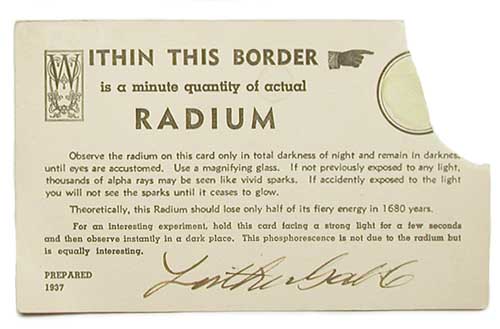
Star of the Lecture Circuit
The publicity for Gable’s presentations referred to him as a "scientist," "chemical engineer," "physicist," "radium expert" and "radiologist." He was none of these. He was a professional lecturer on the chautauqua circuit.
Chautauqua refers to a local gathering, often under a tent, that included presentations by professional speakers and entertainers. The emphasis was on self-improvement. Chautauquas were a development of the earlier Lyceum movement.
Sometime around 1931, Gable began working for the Redpath Bureau, a company based in Chicago that provided the talent for these events. Among other things, Redpath produced the promotional literature with which clients could select one of several canned presentations from a speaker. In Gable’s case, the presentations usually included some mix of radium, black lights, television, atomic energy and space exploration.
A typical bit of advance publicity:
"Doctor Luther Gable—scientist, teacher and inventor, and hailed as one of the most popular speakers on scientific subjects in the U.S.... Billed as an address and a show the likes of which you’ve never seen before... None of the imaginary nonsense Jules Verne ever concocted sounds hall as cockeyed as the things Gable tells for the truth... Gable will concern himself with things that are now happening, or being planned to take place in space... Sound fantastic! It is! But the Gable story is real and as only Gable himself can tell it." (Alamogordo Daily News, Oct. 11, 1964).
Gable, a first rate showman, didn’t disappoint. You can’t make a living for 30 years by giving lectures unless you are good. A major reason for his popularity was his emphasis on "show and tell," e.g., glow-in-the-dark demonstrations using black-lights. Perhaps his favorite demonstration involved passing his "magic boxes" around the audience in a darkened room. While they were nothing more than spinthariscopes, these "perpetual motion fireworks machines" could be plenty impressive if you had never seen one before.
A "show-and-tell" on the road has its risks. At an exhibition in Chicago, one of his radium sources said to be worth $1,000 was stolen. In subsequent press accounts, Gable warned the thief that he was risking the loss of fingers if the radium got under his fingernails, and the loss of his mind if some got in his hair (Beatrice Daily Sun, Sept. 26, 1934).
A similar theft occurred two years earlier in Memphis, Tennessee. Press accounts reported that 3 milligrams of radium had been stolen—a substantial amount, if true. Gable
"issued a warning to the thief to be careful, or it will cause his brain to decay" (Joplin Globe, March 17, 1932). To Gable’s relief, a student confessed to the theft.
"Wishing to do some experimenting of his own, he had secreted the tube on his person and buried it. I could appreciate his enthusiasm and I sent word not to prosecute the lad" (Chicago Sunday Tribune, May 8, 1932).
One of Gable’s specialties was predicting the future, and some of his predictions were pretty darn good.
"laboratories in the sky that will be established where crews of scientists can replace each other, receive daily ration—food, water, oxygen—while they relay TV, radio and radar, report tornadoes, etc." (Alamogordo Daily News. Oct. 11, 1964).
Some were not as good.
"the time will come when young men with technical training will come home and place a ray lamp atop some building In their home town and thus create a climate such as that of Florida or California... and the day will come when we live in a world where no one will have to work more than a hour a day" (Rocky Mount Evening Telegram, Sat., Jan. 17, 1953).
"[Gable] expressed disbelief that Russia has a workable atomic bomb and told his listeners that flying saucers are definitely not objects from another world but said he was not at liberty to tell more concerning them for security reasons" (Rocky Mount Evening Telegram, Sat., Jan. 17, 1953).
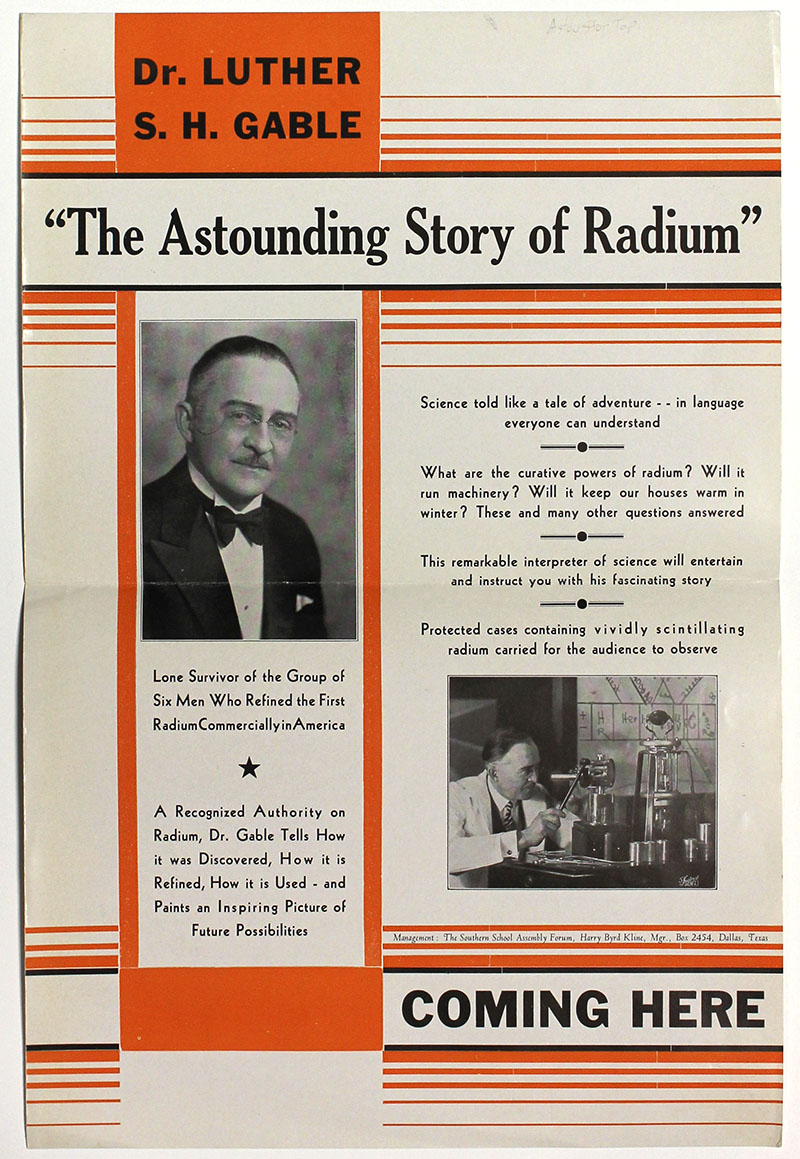
Lecture Circuit Poster
Expenses Paid Trip to MIT
From the Atchison Globe Daily (Jan. 26, 1966):
"Dr. Luther Gable, founder of the Ionic Research Foundation was honored recently when M.I.T. invited him at their expense to spend a week in consultation on radioactivity in their physics department"
Yeah, right.
"They were concerned with Dr. Gable’s work with large amounts of radium, drinking "radium Hi-balls" and "Atomic cocktails" for the last 45 years."
In other words, MIT (meaning Robley Evans) wanted to determine the amount of radium in Gable’s body.
"After nine hours of testing, physical, chemical and 23 X-rays, no residual radium was found, only a fine active young physical condition at 85 years of age."
Good news. The absence of radium is consistent with the intake of water charged with radon.
References
- Arthur Miller. "Personal Reminiscences of the Early History of the Radium Extraction Industry in the USA." in Argonne National Laboratory Health Division Gamma Ray Spectroscopy Group Research Report. July1965 through June 1968. July 1968.
- Catalog of Copyright Entries. Part 1: Books, Group 2. Volume 18. Part 2. 1921.
- Certified List of Domestic and Foreign Corporations for the Year 1922.
- Coffin, R.C. "Radium, Uranium and Vanadium deposits of Southwestern Colorado." Colorado Geological Survey. Bulletin 16. 1921.
